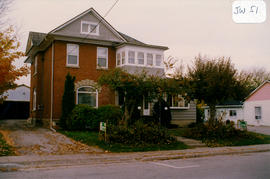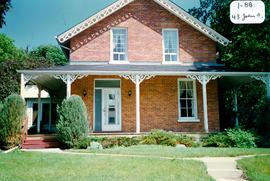51 John Street West - The Neilly House
- CA BWGPL GJ-HB-2017-04-05-14
- Item
- 1995
Part of George Jackson fonds
The Neilly House is located mid-block on the north side at 51 John Street West. It was built around 1900 in the Eclectic Edwardian style. The structure was designed by the same architect who was responsible for designing Bradford’s Anglican Church. This house was built for jeweler Andy Neilly. His business was on Holland St. (across from the Queen’s Hotel). He was a good hunter and sportsman and belonged to the Neilly Rifle Club. The club members met at Eagle Hill on the 13th Line (at the canal on the end of Back and Bingham Streets). This building was later the home of Mac Tobias and his wife. They ran a clothing store on Holland St. (in the second building east of the Queen’s Hotel) before moving to Toronto after World War II. Dr. McMichael, a dentist, lived and had his office here until he moved to Barry’s Bay. Merle and Shirley Woodcock and their family eventually bought, repaired, and remodeled the house.
The two-storey, ‘L’-shaped building with gable roofs has a smooth, brick exterior. There is full height projection with a projected, gable roof above. A textured, wood-shake finish at the flared front gable and the elaborate trim and decoration at the gable window are also Edwardian features. The house has precast voussoirs above the semi-oval transom at the main front window and precast, lug sills. It has loadbearing, brick masonry construction and a stone foundation. According to the 2000 inventory, the new front addition is unsympathetic with the original building. A new, cedar-shingle roof with copper valley flashing was also noted. It considers the building to be well-maintained. (1, 2, 3)
Please contact the Bradford West Gwillimbury Public Library (905-775-3328) if you have any other information about this photo.
George Jackson






